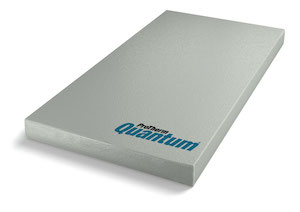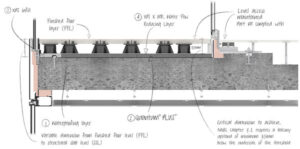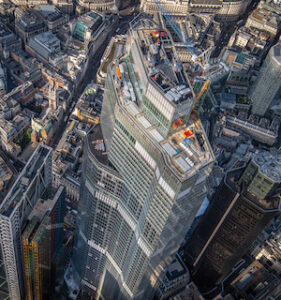View the Radmat entry on BPindex
 Despite being used in the warm and inverted flat roofing market for nearly 10 years Vacuum Insulated Panels, or VIP’s, remain a product that not all architects will be familiar with or will have worked with (VIP’s even have their own Wikipedia page).
Despite being used in the warm and inverted flat roofing market for nearly 10 years Vacuum Insulated Panels, or VIP’s, remain a product that not all architects will be familiar with or will have worked with (VIP’s even have their own Wikipedia page).
VIP’s are a bit of an oddball in the insulation world in that, unlike PIR or XPS insulation, they contain no blowing agent to create a cell structure to provide their insulation value. They also don’t contain air like Rock/Stone Wool insulation does. In fact, they contain nothing but silica sand. Not quite the stuff you find on a beach but very similar to the sand that is cast when installing Liquid Applied Membranes.
 The ‘vacuum’ part of the panel is what produces the ultra-high efficiency insulation performance. The sand is only there to hold the ‘vacuum’ into a shape that we can work with, typically a square or a rectangle. The silver foil that surrounds the sand and its sealing are the clever bit and as you would expect not all foils are the same. Nor is the way the foils are sealed to hold the vacuum. That is why these parts are usually covered by a patent.
The ‘vacuum’ part of the panel is what produces the ultra-high efficiency insulation performance. The sand is only there to hold the ‘vacuum’ into a shape that we can work with, typically a square or a rectangle. The silver foil that surrounds the sand and its sealing are the clever bit and as you would expect not all foils are the same. Nor is the way the foils are sealed to hold the vacuum. That is why these parts are usually covered by a patent.
 Part of the reason why architects may not have worked with VIP’s would be the cost, VIP’s are typically 3 to 5 times per m2 more costly than a typical PIR insulation board, but VIP’s provide a unique advantage when a construction error occurs on a balcony or terrace over heated space.
Part of the reason why architects may not have worked with VIP’s would be the cost, VIP’s are typically 3 to 5 times per m2 more costly than a typical PIR insulation board, but VIP’s provide a unique advantage when a construction error occurs on a balcony or terrace over heated space.
Imaging a structural slab being cast too high to achieve a level threshold. If your slab is 50mm higher than designed the most cost-effective way to achieve the U-value and a level threshold will typically be to use a VIP. Similarly, if you design using a VIP insulation you can utilise the benefit of the significantly reduced thickness, potentially creating the opportunity to increase the number of floors within the overall building height (or increased design flexibility), subject to overall building height.
 The high cost of VIP’s is primarily due to the slow production speed; each panel is formed individually by compressing the dried silica sand into a square or rectangle before wrapping in the aluminium foil, sucking the air out and sealing the foil to hold the vacuum. The resulting product has the best Lambda (thermal) value of any insulation product currently on the market: circa 3.5 more efficient that PIR and 4.5 more than XPS insulation.
The high cost of VIP’s is primarily due to the slow production speed; each panel is formed individually by compressing the dried silica sand into a square or rectangle before wrapping in the aluminium foil, sucking the air out and sealing the foil to hold the vacuum. The resulting product has the best Lambda (thermal) value of any insulation product currently on the market: circa 3.5 more efficient that PIR and 4.5 more than XPS insulation.
One limitation of VIP’s is that the foil cannot be punctured, so methods of protection need to be employed, or the panels coated for protection. VIP’s also cannot be cut, which is why schemes have to be designed for every individual roof, creating a jigsaw that includes PIR or XPS infills at perimeters, penetrations etc.
There are currently a number of methods used to reduce the potential to puncture the aluminium foil:
- Laminated rubber crumb – this only protects the top and bottom of the VIP, leaving the sides unprotected from potential damage.
- Encapsulating in PIR – a higher than normal density PIR encapsulates the VIP. This provides protection on all sides of the VIP but increases the thickness of the VIP significantly. This method is only suitable for warm roof applications and none of the products are currently BBA Certified.
- Elastomeric Coating – the VIP is coated in a waterproof elastomeric coating. This method protects all sides of the VIP and is much thinner than PIR encapsulation.
Choosing the correct VIP for your project has other challenges, especially in today’s compliance conscious market. No British or European Standard currently exists for VIP insulation products. In the absence of a National Standard the simplest option is to seek independent 3rd party certification from bodies like the British Board of Agrément (BBA). Conduct a quick search for ‘Inverted Roof insulation’ on https://www.bbacerts.co.uk/search/ and you will find 7 no. certified EPS or XPS insulation boards, but only 2 no. VIP’s. Change the search to ‘Roof Insulation’ and you get 18 certificates, with the same 2 inverted roof VIP’s. Widen that search to just ‘insulation’ and you get 211 certificates and, yes, you guessed it, only 2 of those are ViP’s.
The only 2 VIP products that are BBA Certified are Radmat ProTherm Quantum PLUS+ PURE and Radmat ProTherm Quantum PLUS+ HYBRID inverted roof solutions. The World’s first Coated VIP’s they are a development of the first VIP’s to achieve a BBA certificate back in 2016. For more information go to https://radmat.com/product-data/protherm-quantum-plus/
